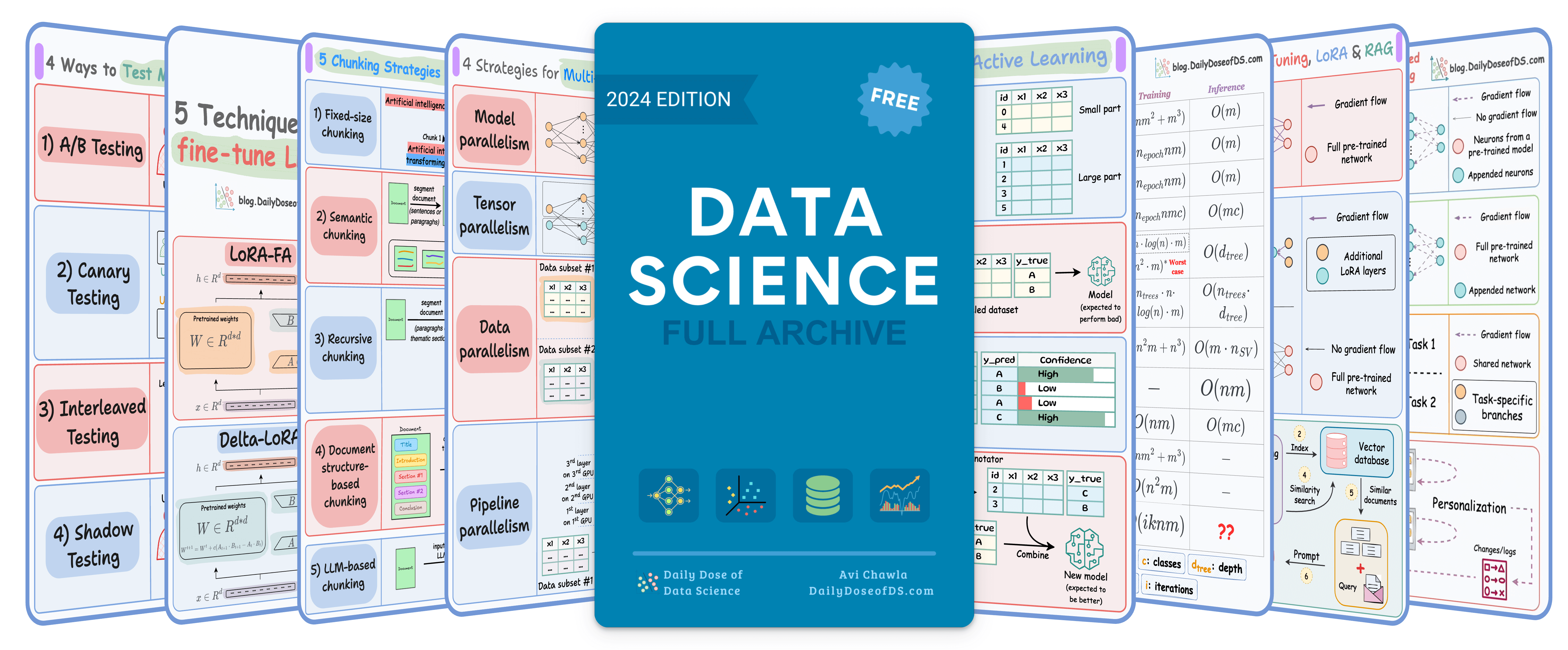

TODAY'S ISSUE
TODAY’S DAILY DOSE OF DATA SCIENCE
Run open-source LLMs locally with Ollama
It's easier to run an open-source LLM locally than most people think.
Today, let's cover a step-by-step, hands-on demo of this.
Here's what the final outcome looks like:
We'll run Microsoft's phi-2 using Ollama, a framework to run open-source LLMs (Llama2, Llama3, and many more) directly from a local machine.
On a side note, we started a beginner-friendly crash course on RAGs recently with implementations. Read the first two parts here:
Let's begin!
Step 1) Download Ollama
Go to Ollama.com, download Ollama, and install it.

Ollama supports several open-source models (listed here). Here are some of them, along with the command to download them:
Step 2) Download phi-2
Next, download phi-2 by running the following command:
Expect the following in your terminal:
Done!
Step 3) Use phi-2
An open-source LLM is now running on your local machine, and you can prompt it as follows:
Customize model
Models running from Ollama can be customized with a prompt. Let's say you want to customize phi-2 to talk like Mario.
Make a copy of the existing modelfile:
Next, open the new file and edit the PROMPT setting:
Next, create your custom model as follows:
Done!
Now run the mario model:
Using an LLM locally was simple, wasn't it?
That said, Ollama elegantly integrates with almost all LLM orchestration frameworks like LlamaIndex, Langchain, etc., which makes it easier to build LLM apps on open-source LLMs.
We have been using them in our beginner-friendly crash course on building RAG systems. Read the first two parts here:
👉 Over to you: What are some ways to run LLMs locally?
CRASH COURSE (37 MINS)
Generate true probabilities with model calibration
Modern neural networks being trained today are highly misleading.
They appear to be heavily overconfident in their predictions.
For instance, if a model predicts an event with a 70% probability, then ideally, out of 100 such predictions, approximately 70 should result in the event occurring.
However, many experiments have revealed that modern neural networks appear to be losing this ability, as depicted below:
- The average confidence of LeNet (an old model) closely matches its accuracy.
- The average confidence of the ResNet (a relatively modern model) is substantially higher than its accuracy.
Calibration solves this.
A model is calibrated if the predicted probabilities align with the actual outcomes.
Handling this is important because the model will be used in decision-making and an overly confident can be fatal.
To exemplify, say a government hospital wants to conduct an expensive medical test on patients.
To ensure that the govt. funding is used optimally, a reliable probability estimate can help the doctors make this decision.
If the model isn't calibrated, it will produce overly confident predictions.
There has been a rising concern in the industry about ensuring that our machine learning models communicate their confidence effectively.
Thus, being able to detect miscalibration and fix is a super skill one can possess.
Learn how to build well-calibrated models in this crash course →
IN CASE YOU MISSED IT
From PyTorch to PyTorch Fabric
Lately, I have been experimenting with Lightning Fabric, which brings together:
- The flexibility of PyTorch.
- And direct access to distributed training features like PyTorch Lightning does.
In a recent issue, I covered the four small changes you can make to your existing PyTorch code to easily scale it to the largest billion-parameter models/LLMs.

Learn how to integrate PyTorch Fabric in PyTorch code here →
THAT'S A WRAP
No-Fluff Industry ML resources to
Succeed in DS/ML roles

At the end of the day, all businesses care about impact. That’s it!
- Can you reduce costs?
- Drive revenue?
- Can you scale ML models?
- Predict trends before they happen?
We have discussed several other topics (with implementations) in the past that align with such topics.
Here are some of them:
- Learn sophisticated graph architectures and how to train them on graph data in this crash course.
- So many real-world NLP systems rely on pairwise context scoring. Learn scalable approaches here.
- Run large models on small devices using Quantization techniques.
- Learn how to generate prediction intervals or sets with strong statistical guarantees for increasing trust using Conformal Predictions.
- Learn how to identify causal relationships and answer business questions using causal inference in this crash course.
- Learn how to scale and implement ML model training in this practical guide.
- Learn 5 techniques with implementation to reliably test ML models in production.
- Learn how to build and implement privacy-first ML systems using Federated Learning.
- Learn 6 techniques with implementation to compress ML models.
All these resources will help you cultivate key skills that businesses and companies care about the most.
SPONSOR US
Advertise to 450k+ data professionals
Our newsletter puts your products and services directly in front of an audience that matters — thousands of leaders, senior data scientists, machine learning engineers, data analysts, etc., around the world.




